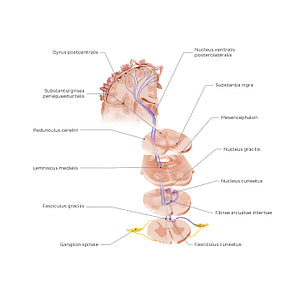Paul Kim
Posterior column-medial lemniscus pathway (PCML) (Latin)
Posterior column-medial lemniscus pathway (PCML) (Latin)
There are three groups of neurons involved in the posterior column-medial lemniscus pathway (PCML): first-order, second-order, and third-order neurons. The cell bodies of first-order neurons are located in the ganglion spinale, which receive the sensory information from the periphery and send their afferent fibers through the radix posterior nervi spinalis into the cornu posterius medullae spinalis. The fibers leave the cornu posteriusn without synapsing and enter the funiculus posterior medullae spinalis, where they form either the fasciculus gracilis or fasciculus cuneatus. The fasciculus gracilis carries sensory information from the lower extremities, while the fasciculus cuneatus carries the information from the upper extremities. The fasciculi gracilis and cuneatus terminate in the pars inferior medullae oblongatae by synapsing with the second-order neurons found in the nucleus gracilis and nucleus cuneate, respectively. The second-order neurons project their axons, called the fibrae arcuatae internae, that cross the midline of the midbrain to the contralateral side. This represents the point of decussation of the PCML pathway, after which the lemniscus medialis is formed. The lemniscus medialis continues towards the thalamus, where it synapses with third-order neurons found in the nucleus ventralis posterolateralis. Fibers from these project through the crus posterius capsulae internae to reach the primary somatosensory cortex in the gyrus postcentralis of the lobus parietalis. Here, sensation discrimitation is 'mapped' using a somatotopic arrangement, represented as the sensory homunculus.
Precio habitual
$7.56 USD
Precio habitual
Precio de oferta
$7.56 USD
Precio unitario
por
No se pudo cargar la disponibilidad de retiro


#E0BA36
#A46655
#622427
#746E6E
#F7E09B y #D2B2AC

